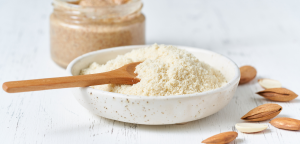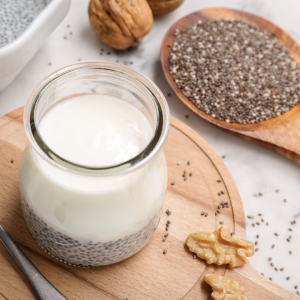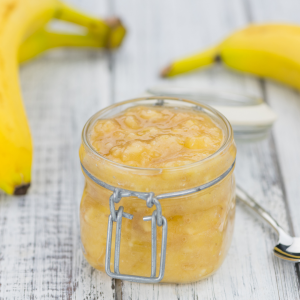The Role of Binders in Baking with Nut Flours

Gluten in wheat flour serves as a binder for the various ingredients in a recipe and helps to holds everything together. When you’re baking with nut flours in the absence of gluten, you’ll need to add alternative binders to achieve that same texture and fluffiness. Here are our top recommendations for gluten-free baking binders.

Eggs
For those of you who aren’t plant-based, whole eggs function as the number one binder in baked goods because of their protein content and how they gel as they heat up. It helps to achieve proper form, function, appearance, taste, and texture while also forming air bubbles that give the baked goods a light and enjoyable texture. For this reason, if you are substituting wheat flour with nut flours, you also have to increase the number of eggs in the recipe by about twofold.
Apart from eggs, there is a broad list of alternative binders in gluten-free baking for people who have egg-intolerance, are on a plant-based diet, or simply run out of eggs at home (we’ve all been there). Here are a few personal favorites and how each of them works in recipes.
Chia Seeds
Chias have the ability to gel pretty quickly when mixed with liquid. This makes them a perfect binder in gluten-free baking. To replace one egg, simply add 1 tablespoon of ground chia seeds to 3 tablespoons of water, milk or juice, mix it well, and let it sit for at least 15 minutes. Don’t forget to mix it every once in a while to avoid lumps. Use the mixture in nut flour recipes as a binding agent and to add more nutrition.
Ground Flaxseeds or Flaxseed Meal
Just like chia seeds, flaxseeds can form a gel and act as a binder. 1 tablespoon of ground flaxseed meal mixed with 3 tablespoons of water or the wet ingredients replaces 1 egg. As flaxseed meal is the powdered form, you can also just add the flaxseed meal to the dry ingredients. If you ever come across the word “flax egg” in vegan recipes, this is how you should make it.
Nut/Seed Butters and Oils
The best binder among all the oils is coconut oil. Adding about 1/4 cup of melted coconut oil to any recipe usually replaces 1 egg. Nut and seed butters are high in fat and fiber, and they are perfect if you don’t want too much moisture. Nut and seed butters work best if used in combination with flax or chia seeds or to replace 1~2 of the eggs in a recipe.
Applesauce, Mashed Bananas, Ripe Plantains
Applesauce can serve as a great binding agent due to its high fiber. It also provides good moisture, smooth texture and acts as a thickening agent in gluten free baking. Substitute 1/3 cup of applesauce for each egg in your recipes. Bananas and ripe plantains are both high in fiber and starch, which gives them great binding ability. You can replace 1 egg with 1/4 cup of mashed bananas or ripe plantains.
Sweet Potato, Yam or Pumpkin Puree
Though less binding than the above-mentioned substitutes, sweet potato, yum or pumpkin purees can help hold ingredients together in a recipe. To replace an egg in your recipes, use 1/4 to 1/3 cup of such puree.
Puree Dried Fruits
Due to their stickiness, puree dried fruits like dates or raisins work well as sweeteners and as binders. They are perfect for cheesecake and pie crusts, granola bars, energy balls and other nut-flour based, no-bake desserts. Pureeing dried fruits is simple – just soak them in warm water for a few hours and blend to get a smooth consistency.
Starches
Nut flours can work well in recipes, especially when combined with other gluten-free powders/flours/starches that are also great binders. Arrowroot powder/flour or tapioca starch/flour are both effective thickening and binding agents for the batter. When baked, they lighten up the texture and hold the structure of baked goods.
Agar Powder
Agar powder is derived from finely ground marine red algae seaweed and works similarly to gelatin as a binder. You can substitute an egg simply by dissolving 1 tablespoon of agar powder with 3 tablespoons of water or milk. Sprinkle the powder over the liquid and let it soak for 5 to 10 minutes to dissolve.
Want mouthwatering results? Try testing out different combinations of the above binding ingredients rather than relying on just one item. While most of the alternative binders are versatile and usable in any type of nut flour recipe, some are better in certain types of recipes than others. Cakes call for coconut oil or applesauce. Loaves do well with sweet potatoes, bananas, and zucchini. Chocolate cakes are simply decadent with pureed prunes and dates, while cookies work well with nut and seed butters. Experimenting is key – so go nuts with it!
Article by Annie Siegfried
